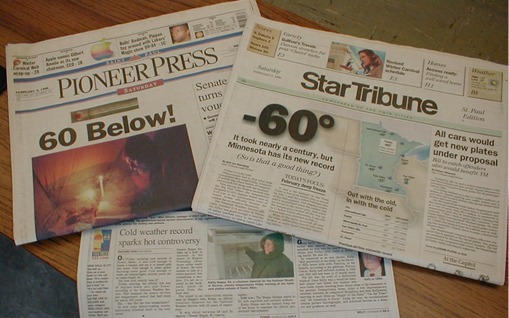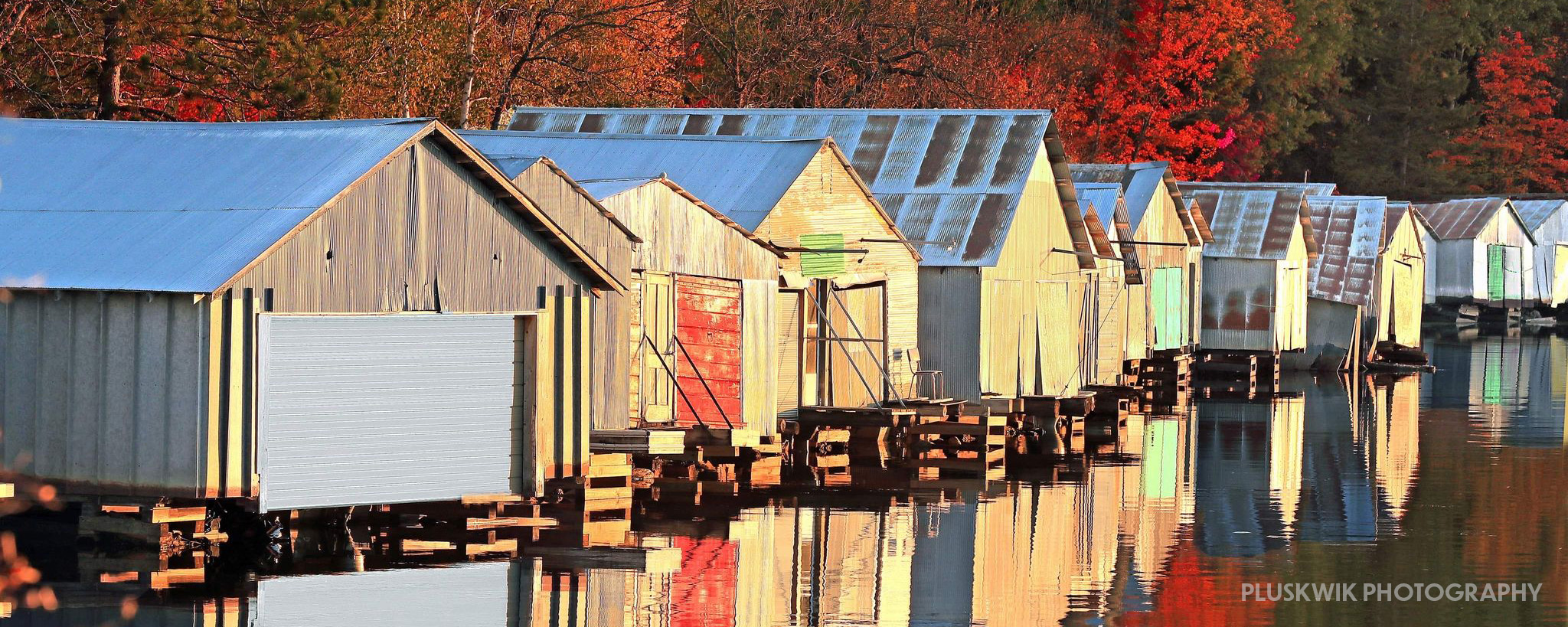60° Below Zero
In a state where winter endurance stories are passed from generation to generation, the real tales of what happened on the coldest day on state record are perhaps just now taking on full dimension these decades later.
February 2, 1996 Put Tower in National News Headlines
Residents of the Tower and Embarrass area know that their winters will be cold and have come to expect the frigid winter weather. Located in a low basin of the Embarrass River Valley, the Vermilion Range borders the northern end and the Laurentian Divide borders the southern end and moraines are found at right angles to this valley. Gravity and these natural barriers cause denser, heavier cold air to drain into the river valley basin creating a cold pool of air making it a natural cold spot.
Tower and Embarrass frequently record some of the lowest temperatures in the state. These frigid temperatures are recorded daily by local volunteer cooperative weather observers and relayed to the National Weather Service and across the country.
In 1996, for two days—January 31 and February 1, the temperatures were exceptionally cold, hovering at -55 and -58 Fahrenheit. The next day would be worse. The official temperature, as reported by Kathy Hoppa, Tower Station national weather observer for the National Oceanic and Atmospheric Administration (NOAA), had an official low of 59.5° registered at 9:10 am. NOAA advised that the Minnesota state temperature reading would be “rounded off” to a -60° F.
Life did not come to a standstill. School was in session on these frigid -50°days. Folks who could get their cars started were driving them around town like any other day. However, day three at -60 caused the local schools to close for a couple of days and some folks reported that their water lines froze and burst.
Two towns were battling to set a new record cold temperature…
The weather setup with a high-pressure system over central Canada continuously funneled in arctic, cold air from the North Pole to right over the Northland. Clear skies and calm winds from the high pressure allowed any warmth from the day to leave and escape back into the atmosphere. These came together to cause that really cold night.
Weather watchers knew a record was probably going to be broken or very close to it. The media frenzy was there and everybody was talking about it. It had been cold for a few days before that, with -50 actual temperatures, but on the day of February 2nd, the numbers started dropping even more.
Just down the road from Tower sits Embarrass, located in the Embarrass River Valley, and historically the area’s cold spot. It was a near-party atmosphere in the area with newspaper, TV and radio reporters all gathering on the forecast of potential state-record cold. There were those who relished the opportunity to earn bragging rights. A group of friends doubled up sleeping bags and dug into hardened snow drifts for a long night of myth-making at Timber Hall in Embarrass.
Radio personality and historian Mike Hillman memorably entertained all by narrating a live feed to local radio station WELY from his tent at the Tower weather station. His claim to fame was successfully pounding a nail with a frozen banana on air.
The media folks were heading to Embarrass—as all signs pointed to Embarrass taking the record cold title—until their thermometer broke. On that day of February 2nd, Embarrass Station national weather observer Roland Fowler thought he might have had the record… until Fowler’s National Weather Service official thermometer went on the blink at 3 a.m.
“Well, here’s what happened,” he explained factually. “The mercury in the thermometer broke on me. It separated because of the cold temperatures at 52° below zero.” He took photos of four other thermometers registering -62 and -64, sending them to the Weather Service.
But the thermometer has to be in the official box called a “cotton region shelter” which is white in color and off of the ground. This is important because it calculates a real atmospheric temperature without sun rays, ground heat and wind affecting it. Unfortunately, Fowler’s back-up thermometer wasn’t in the official box. The temperatures of the other thermometers were not considered official. Tower’s official thermometer was working perfectly and because of that, Tower was the winner that very cold day.
Tower’s new mark of -60° shattered the state’s record of 59 below zero set at Federal Dam near Leech Lake in 1899. Tower’s 60 below zero was also the coldest temperature ever recorded east of the Mississippi River.
But why Tower?
Kathy Hoppa, whose home is located three miles south of Tower on Highway 135, is situated in a slight topographic bowl which allows cold air to drain in from nearby areas.
According to the Minnesota State Climatology Office, Tower had 44 inches of snow on the ground at the time that had nearly reached up to the thermometer. Hoppa’s thermometer was “official”—in a white louvered box about five feet above the bare ground. Cold air sinks, so the ground (top of the snow) being closer to the thermometer essentially brought cold air to the thermometer.
The air mass that produced the record low at Tower also produced bitterly cold temperatures across the rest of Minnesota. This cold snap was a record-breaker, but it was short-lived. Tower rebounded by an astounding 108 degrees in just six days, recording a high of 48 F on February 8th.
Tower’s Celebrates Record Breaking Cold
People living in Tower enjoyed their record setting day. “We’ve missed out on some state basketball tournaments and football tournaments, but now we’re state champs,” Gary Burgess, Tower’s former mayor, said on that coldest of Minnesota days. “We’ve got our state championship.”
Mayor Herbert Lamppa, was besieged with media calls and live CNN and WCCO phone interviews. He received calls from Texas, Washington D.C., Honolulu, Los Angeles, New York City and Boston. The City of Tower was put on the map. Lamppa told callers that people in Tower were going about their business pretty much as usual and invited everyone to visit Tower in June and July. Breitung police chief Jim Hill was interviewed live via telephone by Garrison Keillor on Minnesota Public Radio’s “A Prairie Home Companion Show.”
People from elsewhere wanted to have the experience of being in such cold weather. A family of five from Bloomington, Minnesota announced that they drove that night to northern Minnesota so they could experience the record-breaking cold. A souvenir coffee cup, featuring the frigid temperatures, was manufactured and sold in the local stores that summer. Photos exist of the Tower State Bank’s digital sign flashing a temperature of -62 that morning. In fact, the bank used that image for its coffee cup promotion that year.
The following day, on February 3rd, the cold snap broke and Tower was back to “warmer” weather…-32. However, Mother Nature was teasing Tower. The next day Kathy Hoppa recorded -46. After that, temperatures resumed their normal routine at -20 and up.
| High Temperature | Low Temperature | |
| January 29 | 5 | -28 |
| January 30 | 0 | -35 |
| January 31 | -7 | -55 |
| February 1 | -6 | -58 |
| February 2 | -16 | -60 |
| February 3 | -19 | -32 |
| February 4 | -4 | -46 |
| February 5 | 0 | -20 |
| February 6 | 10 | -2 |
| February 7 | 31 | 20 |
If you are wondering how our state-record low of -60 stacks up nationally, the all-time U.S. low is -80 degrees F, observed on January 23, 1971 at Prospect Creek, Alaska. In the contiguous U.S., Montana (-70 F), Wyoming (-66 F), and Colorado (-61 F) all have colder record lows than Minnesota. Along with North Dakota, Idaho also shares Minnesota’s record-low temperature.

